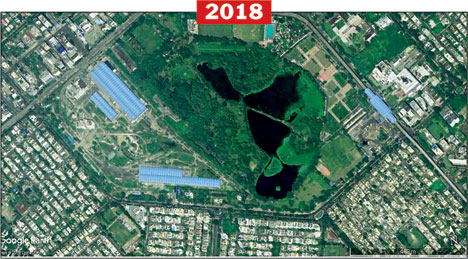

Central Park, showcased as the lungs of Salt Lake in its formative years, has lost close to 50 per cent of its sprawling green space over the years mostly to a slew of government projects which have come up allegedly violating the norms.
The Telegraph Salt Lake took a trip around Central Park on Wednesday and found that almost the entire outer portion of the park has been carved out, largely concretised and kept out of bounds for citizens by a series of government projects interspersed with private ones allowed by the urban development department. The “encroachment” starts with expansive local and international bus stands at the western end, followed by a permanent fair ground, swimming complex and municipal sports academy, CMDA water reservoir, Metro Railway car-shed, municipal stackyard and some temporary hutments to house municipal conservancy staff and finally a cricket academy.
“Out of around 152 acres originally covered by Central Park, apart from 75 acres of Banabitan, a green spread, and a children’s park the rest have been hijacked and largely concretised by a number of government projects,” complained Arunangsu Chakrabarty of GD Block who has already filed a couple of cases against the government for the encroachments.
“As per the West Bengal Town and Country Planning and Development Act, 1979, no large permanent construction is allowed in a park. Moreover, the original master plan of Salt Lake, developed sector-wise by a Serbian consultant company in between 1967 and 1981, never planned anything within Central Park other than a green verge. As no new master plan for Salt Lake has come up after that, any dispersion from that master plan is illegal. Forget about illegal encroachment, even multistoried buildings have come within Central Park,” added Chakrabarty, whose objection to such a building within the park holding social events was upheld by the high court and at present lies with the Supreme Court.
Another public interest litigation against the fair ground in particular but also covering other alleged encroachments including the Metro car shed is currently being dealt with by the high court. “Though Metro Railway did not attend the hearing, the judge made it clear that the verdict would cover the agency,” said Chakrabarty.
While the CMDA booster pumping station was the first encroachment, Metro Railway has been the latest and biggest encroacher. “In the initial booklet of Salt Lake, released by the then urban development minister Prasanta Sur in 1981, Central Park was referred to as the lungs of the township,” remembered Amitava Majumdar, an activist from CA Block who fought the violations along with Chakrabarty. “As a matter of fact, even in 2008, many eminent citizens of Salt Lake protested against the mindless massacre of Central Park which included many who are part of the present regime but were in opposition then. However the violation, initiated in the Left Front era, continues unabated,” rued Majumdar.
Tapas Ghatak, a former urban development expert of CMDA and resident of Sourav Abasan, pointed out that most of these encroachments occurred randomly and did not follow any earmarked land-use development control plan, a mandatory exercise. “Luckily, the Maidan is under the army’s control, otherwise it would have suffered the same fate. Violating environment is the lowest hanging fruit for most politicians and executives,” added the expert.
A retired bureaucrat recounted how any permanent construction within Central Park was strictly prohibited in the initial years.
“In our original project report, it was specified that there would be no permanent construction in Central Park. That is why even the mechanical workshop during the construction of the Salt Lake project, where the cement would be stored and tractors and bulldozers parked, were made of asbestos and tin,” said Pran Kishore Chatterjee, who was the administrator of Salt Lake Reclamation and Development Project during 1989-96.
Chatterjee pointed out that “when in the mid-90s for the first time five acres were carved out of Central Park to build a booster pumping station, a cabinet clearance was needed.”
“Bidhannagar Municipal Sports Complex was supposed to be a tent as there are many on the Maidan but unfortunately it ended up as a building,” he added.
HOW THE GREEN PIE HAS BEEN DIVIDED

“It’s extremely unfortunate. At this rate (of encroaching Central Park), there will be no space to breathe in Salt Lake after 50 years. The government should come out clear on its policy about Central Park and, if required, undertake a study about the damages being done and corrections required,” observed former Calcutta High Court judge and chairman of Citizens’ Forum Salt Lake Soumitra Sen, a resident of CL Block.
Government officials are defensive about the allegations of environment experts and citizens. “The issue is pending in court and hence I will not make any comment apart from the fact that municipal corporation has no control over Central Park. We are prepared to shift the municipal stackyard if the court passes any order or the urban development department, which controls Central Park, asks us to vacate,” observed Bidhannagar mayor Sabyasachi Dutta.
A senior official, who refused to be named, pointed out that most of the violations happened in the Left Front era but admitted that Metro Railway’s entry, which happened during the current Trinamul Congress regime, is the mother of all encroachments. “Do they really require 40 acres?” wondered the official, accepting that greater vigilance and study were required before allotment of land to various projects.
Meanwhile, Central Park continues to be encroached, its green cover trampled by layers of cement or concrete, its name almost losing relevance and its status of being the township’s lungs under severe threat.
Input from Sudeshna Banerjee
Are you affected by Central Park losing its green cover?
Write to The Telegraph Salt Lake, 6 Prafulla Sarkar Street, Calcutta 700001 or email to saltlake@abpmail.com










